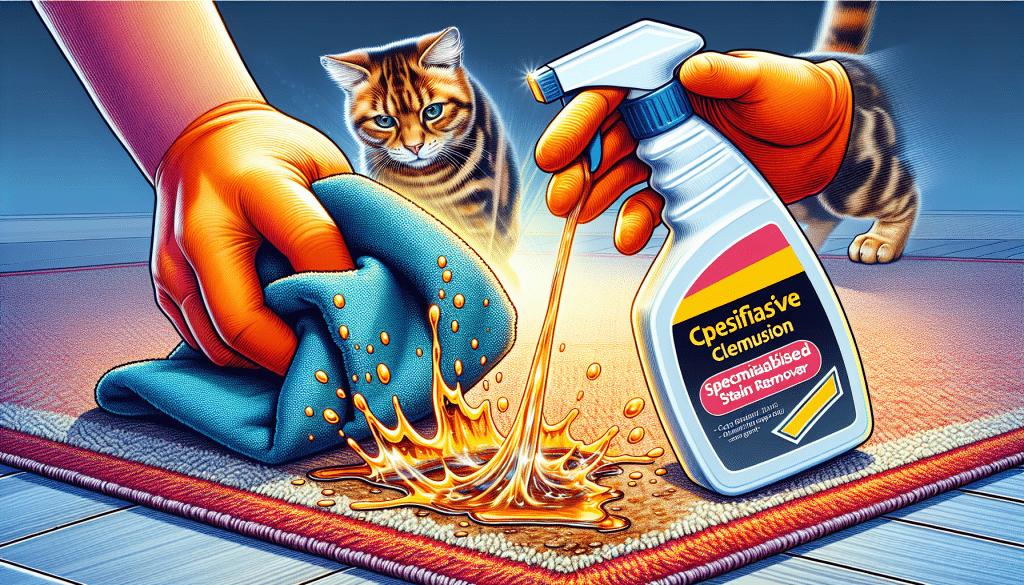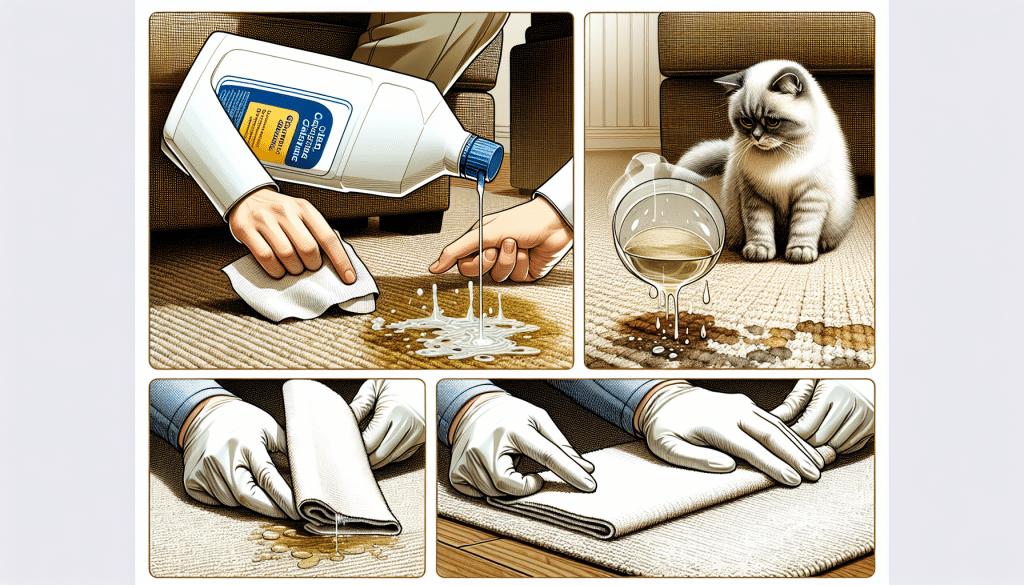So, you’ve found yourself dealing with that all-too-familiar problem of cat urine stains on your carpet. Don’t worry, it happens to the best of us. But fear not, because in this article, we’re going to show you some tried and true methods for getting rid of those pesky stains and lingering odors. From DIY solutions to specialized products, we’ve got you covered. Say goodbye to those embarrassing stains and hello to fresh, clean carpets once again. Let’s get started!

Understanding The Stain Problem
Cat urine can be quite a challenge to remove from carpets, and understanding why it is so difficult can help us tackle the issue more effectively. One of the main reasons is that cat urine contains uric acid, which makes it stick to surfaces and resist normal cleaning methods. Additionally, cat urine has a strong odor that can linger even after the stain appears to be gone. This is because the urine can seep into the carpet fibers and underlying padding, making thorough stain removal a necessity.
The implications of not properly removing cat urine stains are not just limited to the unpleasant odor. If left untreated, the uric acid in the urine can crystallize over time and cause discoloration of the carpet fibers. This can make the stain more permanent and difficult to remove. Moreover, the presence of urine odor can encourage a cat to continue marking the same spot, perpetuating the problem.
The Initial Steps
When you discover a cat urine stain, it is crucial to act quickly for effective stain rectification. The longer the stain sits, the harder it becomes to remove. Start by using a clean cloth or paper towel to sop up as much of the urine as possible. Be careful not to rub the stain, as this can cause it to spread further into the carpet fibers.
While it may be tempting to use heat for faster drying, it is important to avoid this when cleaning cat urine stains. Heat can actually set the stain and odor into the carpet, making it even more challenging to remove.

Methods for Removing Fresh Stains
For fresh cat urine stains, there are several methods you can try at home. One simple approach is to create a solution using dish soap and water. Mix a few drops of dish soap with warm water, apply it to the stain, and gently blot the area with a clean cloth. This method can help remove both the stain and the odor.
Another effective method for fresh stains is combining baking soda and white vinegar. Start by sprinkling baking soda over the affected area to absorb the odor. Then, mix equal parts white vinegar and warm water in a spray bottle and lightly spray it onto the stain. Allow the mixture to sit for a few minutes before blotting it with a cloth. Finally, rinse the area thoroughly with warm water to remove any residue.
Enzyme-based cleaners are also highly effective in eliminating fresh cat urine stains. These cleaners break down the uric acid into non-odorous compounds, leaving your carpet fresh and stain-free. Follow the instructions on the product label for the best results.
Methods for Removing Old, Set-In Stains
When dealing with old and set-in cat urine stains, locating the stain is the first challenge. You can use your sense of smell or a blacklight to identify the affected area. Once found, start by rinsing the stain with cool water to dilute and remove as much urine as possible.
Using an extraction method, such as a wet/dry vacuum or carpet extractor, can be beneficial for old stains. These machines help remove deep-seated urine from the carpet, ensuring a more thorough cleaning. After extraction, it is essential to treat the area with an enzyme cleaner specifically designed for older stains. This will break down any remaining uric acid and eliminate the odor.

DIY Homemade Stain Removers
If you prefer a more natural approach, there are DIY homemade stain removers you can try. One option is to make a vinegar solution by mixing equal parts white vinegar and water. Apply the solution to the stain, let it sit for a few minutes, and then blot it with a clean cloth. Vinegar is known for its ability to neutralize odors and can be effective in removing cat urine stains.
Another homemade remedy involves creating a paste using baking soda and hydrogen peroxide. Start by sprinkling baking soda over the stain, then mix hydrogen peroxide with a small amount of dish soap to form a paste. Apply the paste to the stain and gently scrub it with a soft brush. Allow it to sit for a few hours before vacuuming up the baking soda residue.
For a citrus-enzyme cleaner, combine citrus peels with water in a jar and let it sit for a few weeks. Strain the liquid and transfer it to a spray bottle. This homemade cleaner can be sprayed onto cat urine stains and left to dry naturally. The enzymes in the citrus peels will help break down the uric acid and eliminate the odor.
Commercial Products for Cat Stain Remediation
If you prefer ready-to-use solutions, there are many commercial enzyme-based cleaners available in the market. These products are specifically formulated to tackle cat urine stains and odors. Look for cleaners with high enzyme concentrations for more effective stain removal. Follow the instructions provided by the manufacturer for best results, as different products may have varying application methods.
When using commercial stain removers, it is important to test them on a small, inconspicuous area of your carpet first to ensure they do not cause any discoloration or damage. Apply the cleaner to the stain and follow the instructions for the appropriate contact time before blotting or rinsing the area.
Dealing with Stains on Different Types of Carpets
Different types of carpets require specific care when it comes to removing cat urine stains. For wool carpets, it is crucial to act quickly to prevent the urine from penetrating too deeply. Blot the stain gently with a clean cloth and avoid rubbing or scrubbing, as this can damage the delicate wool fibers. Use gentle cleaning solutions and take extra care during the drying process.
Synthetic carpets are generally more resilient to stains, but thorough cleaning is still necessary. Follow the methods mentioned earlier, but keep in mind that some synthetic fibers may be sensitive to certain cleaning agents. Check the manufacturer’s guidelines for cleaning recommendations specific to your carpet.
Berber carpets often have a looped construction, which can trap and hold onto cat urine. When dealing with stains on Berber carpets, it is important to blot the stain gently with a clean cloth, working from the outside towards the center. Avoid scrubbing or using excessive moisture, as this can cause the loops to unravel. If the stain persists, consider seeking professional help to prevent further damage to your carpet.
Preventing Future Cat Urine Stains
Addressing inappropriate urination behavior in cats is key to preventing future stains. Consult with a veterinarian to rule out any underlying medical issues that may be causing your cat to urinate outside the litter box. If behavioral issues are identified, work with a professional animal behaviorist to address and modify the behavior.
Proper litter box training is crucial for preventing accidents. Ensure that you have enough litter boxes for the number of cats in your home and clean them regularly. Place the litter boxes in quiet, accessible areas where your cat feels comfortable using them.
Using pet stain repellent products can also be beneficial in discouraging cats from urinating outside the litter box. These products emit scents that cats find unpleasant, deterring them from marking their territory on carpets and other surfaces.
Additional Tips and Warnings
When using cleaning products, always prioritize your safety. Follow the instructions provided by the manufacturer and avoid mixing different chemicals together, as this can create harmful fumes or reactions. Wear protective gloves and work in a well-ventilated area to minimize exposure to cleaning agents.
There are also certain actions to avoid when removing cat urine stains. Do not use steam cleaners or hot water, as these can set the stain and make it more difficult to remove. Avoid using strong-smelling cleaning solutions, as the strong odors may attract your cat back to the same spot. Additionally, never use bleach on urine stains, as it can react with the uric acid and produce harmful gases.
Maintaining overall carpet cleanliness is important in preventing cat urine stains from becoming a recurring issue. Regular vacuuming and deep cleaning can help remove any lingering odors and prevent the buildup of dirt and debris that can attract cats to urinate in the same spot.
When to Seek Professional Help
If you have tried various methods to remove cat urine stains and the problem persists, it may be time to seek professional help. Signs of persistent urine stains include recurring odor or discoloration despite thorough cleaning efforts. Professional carpet cleaning companies have specialized equipment and expertise to tackle stubborn stains effectively.
Before hiring a carpet cleaning company, do your research to find a reputable and trustworthy service provider. Look for reviews and recommendations, and inquire about their experience in dealing with cat urine stains specifically. Additionally, consider the cost-effectiveness of professional cleaning services compared to the potential damage that can be caused by DIY attempts.
In conclusion, removing cat urine stains from carpets can be a challenging task, but with the right approach and techniques, it is possible to achieve effective results. Take immediate action, choose suitable cleaning methods based on the freshness of the stains, and consider both homemade and commercial solutions. Remember to address any underlying behavioral issues in your cats and take preventative measures to minimize future stains. By following these guidelines, you can maintain a clean and odor-free carpet while ensuring the well-being of your feline companions.



